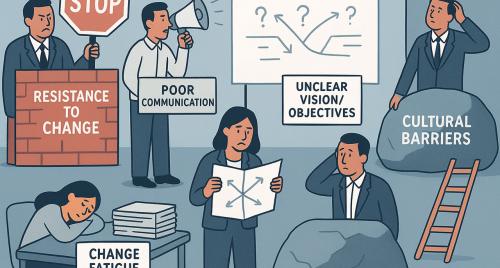
Stakeholder management is one of those skills that can make or break your success as a project, change or transformation practitioner and just generally in leadership roles.
I have seen people fail in their jobs with an absolute inability to flex their style to suit the needs of their stakeholders. I can talk from personal experience in a previous career that not putting the time and effort into stakeholder management can jump up and bite you when least expected!
I have attempted to capture some of the strategies I put in place and teach others and would love to hear other strategies that you employ!
So firstly, why have a structured approach?
- Key people can have a BIG impact both positively and negatively on your ability to be successful and to deliver outcomes.
- This influence they have can either help or hinder and even at times STOP implementations.
- It's about managing risk – thinking about what we do as change practitioners, we help manage the people risk. Having informed advocates can help mitigate issues and or stop them before things spread.
- Having a thoughtful approach ensures you don’t under service stakeholders you need to pay attention to, and conversely over service the ones that are “easy” to talk to.
- We need to think about the messages stakeholders need at different phases of projects and initiatives, so being considered in your approach means you think this through.
- Different stakeholders have different needs, different interests, different motivations, and different styles.
- It helps us deliver the right outcomes as smoothly and easily as possible.
- We want to remove blockers and prevent poor perceptions and build ongoing relationships for the future.
Okay, so I am a fan of a Stakeholder Matrix – I don’t mind if it’s a 2 x 2 or a 3 x 3, but choose one and complete it on key stakeholders to really work out the ones that need to be managed closely. It forces you to really think about who has influence and impact, and this isn’t just about hierarchy, it's about finding the key influencers in the business.
Once you have done that, (I recommend doing this with some of your colleagues together, as you get a better and more robust result), you then need to put some strategies into place to manage the key stakeholders. I suggest you keep this information in an Excel spreadsheet (you can keep the information confidential this way and be more open about the blockers) or even up on a project wall (ensuring you remove anything controversial of course)!
You want to be capturing things like:
- Name
- Title
- Level interest/impact
- Level influence
- Motivation (WIIFT)
- How they can help/hinder/block
- Who influences them
- Who will relationship manage them
- Engagement approach
- Rhythm
Managing stakeholders this way needs to be an ONGOING thing, you cant do it once and put it aside – it's living and breathing! Also, if you have a group of you managing the stakeholders (relationship managers), I suggest you get together regularly and check in with how the key stakeholders are going. Doing this also holds people to account to ensure they are managing the relationships actively if you are having to trust that stakeholder management to others in your team.
Some top tips from me to really nail it:
- Doing your stakeholder mapping and plan is not a once-off – do it regularly.
- Consider the styles people have – use profiling tools or even tools like an Empathy Map to understand who they are and how you need to adapt to their style. I personally use a tool called Interaction Styles – you can listen to our webinars on this tool.
- Communicate, communicate, communicate – what is relevant to them, when they want to hear it.
- Consult early and often – agree on a rhythm with them, sit it in place and stick to it to prevent disengagement.
- It's all about relationship building – take the time to nurture the relationship.
- Assertive statements can improve cut through (not dominant or passive). Be clear – ask if they are happy with the progress, ask if there are issues, ask if the level of information you are providing is hitting the mark.
- Remember to stay focused on the outcomes you are after and the outcomes they are after.
- Set a relationship manager and manage the relationship managers!
- Consider indirect engagement beforehand – talk to the people they trust, get some background and get them on side.
- Finally, you need to have behavioural flexibility – if it's not working then change the approach, the communication or even change the relationship manager. The ownership is on you to make it work!
And FINALLY from me – remember good stakeholder management is about creating strong ownership in your stakeholders for the outcomes you are seeking. Take that monkey off your back as practitioners and get the key stakeholders owning the outcomes!







